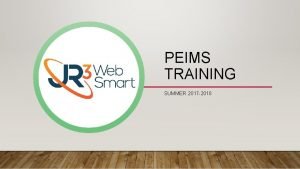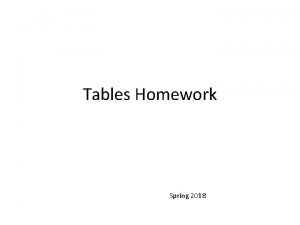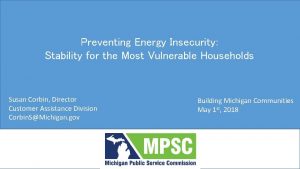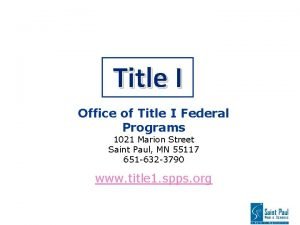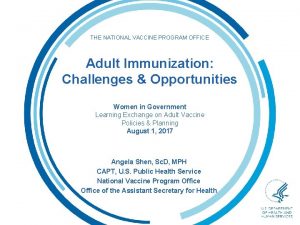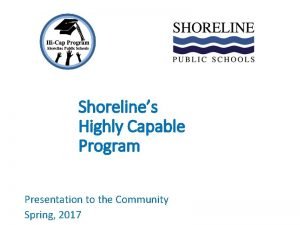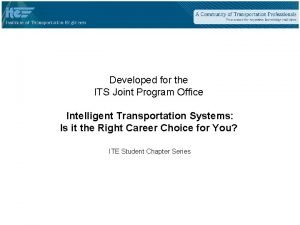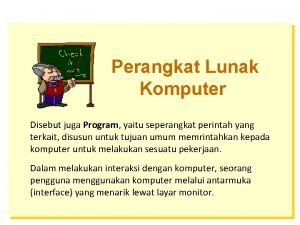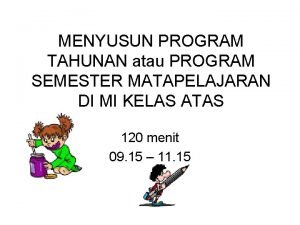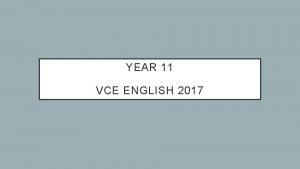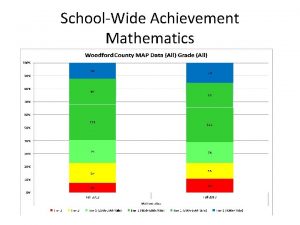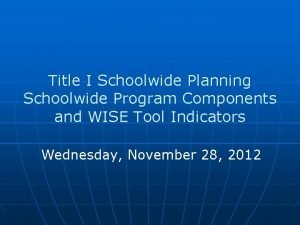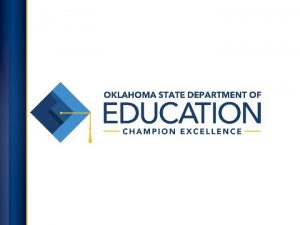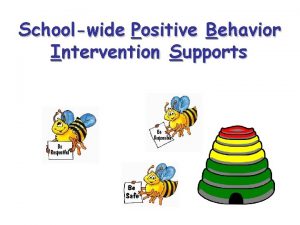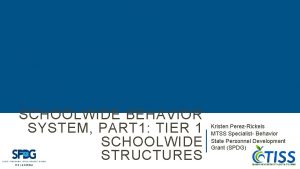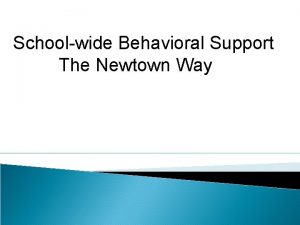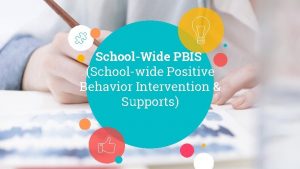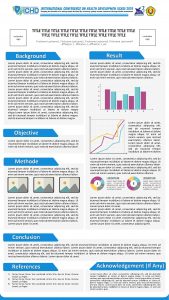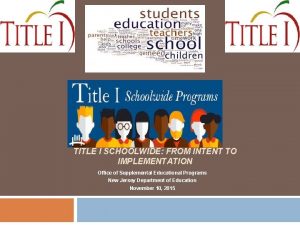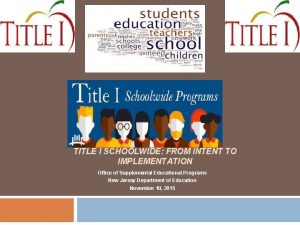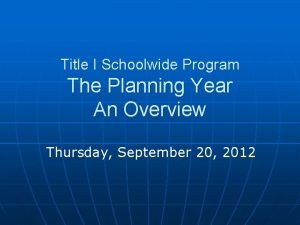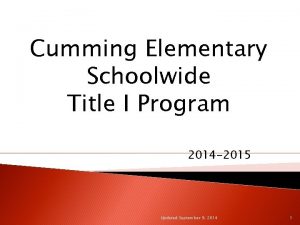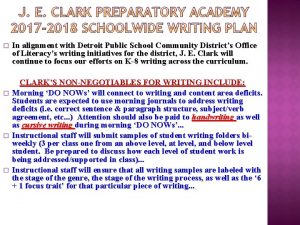Title I Schoolwide Program FY 2017 2018 Office
































- Slides: 32


Title I Schoolwide Program FY 2017 -2018 Office of Federal Programs September 13, 2017

Goals for Today • Timelines for the schoolwide process. • Compare Title I Schoolwide Program and Title I Targeted Assistance Program. • Provide information and guidance about transitioning from a Title I Targeted Assistance Program to a Title I Schoolwide Program. 3

Timelines • Submit the Letter of Intent to participate in the 2017 -2018 Schoolwide program. This is done through the Comprehensive District Academic Plan (CDAP) in the Grants Management System (GMS), and the deadline for submission was June 30, 2017. • Upload the Schoolwide Plan in GMS no later than May 1, 2018 • Schoolwide plans will be reviewed by OSDE reviewers as they are submitted, and approved on a daily basis. • After the school principal receives the approval letter from OSDE, the school may start operating as Schoolwide immediately. 4

Schoolwide Plan Access in GMS • The school principal will need access to the Schoolwide Plan in GMS in Single-Sign-On (SSO). • GMS access to principals is granted by LEA Superintendent. • The plan works like any other application in GMS: • Type directly on the webpage; • May type in a word document, then copy and paste into the GMS application; • Each section has a character limit –think main idea and be concise; • Can be printed as a PDF document. 5

Poverty level threshold “ A school that serves an eligible school attendance area in which less than 40 percent of the children enrolled in the school are from such families, may operate a schoolwide program under this section if the school receives a waiver from the State educational agency to do so, after taking into account how a schoolwide program will be best serve the needs of the students in the school served under this part in improving academic achievement and other factors. ” [ESSA, Section 1114(a)(1)(B)] 6

Poverty level threshold (cont. ) To meet this provision, starting with the school year 2017 -2018, the Office of Federal Programs (OFP) will allow LEAs with schools that have the poverty level less than 40 percent to submit a Letter of Intent (which will serve as a waiver request) to operate a schoolwide program. 7

Comparison of Title I Programs Targeted • Section 1115 of NCLB. • Section 1009 of ESSA. Schoolwide • Section 1114 of NCLB. • Section 1008 of ESSA • It is a supplemental service • It is a comprehensive school program to assist low reform model that includes achieving students. extended learning time for low achieving students. • Uses Title I funds to serve • Uses Title I funds to meet the needs of all students in the only those students who school. have been identified as most at-risk. 8

Comparison of Title I Programs (cont. ) Targeted • Requires to use of multiple, educationally related objectives, and uniformly applied criteria to identify students. • Title I teachers and administrators ensure regulations are met. 9 Schoolwide • No requirement for identification of students. • All staff supports the Schoolwide Program.

Comparison of Title I Programs (cont. ) Targeted Schoolwide • Requires regular • Requires the review of monitoring of the student services and the program, and the plan assessment of students on may be revised when an on-going basis, and necessary. the plan may be revised when necessary. 1 0

Comparison of Title I Programs (cont. ) Both programs must be compliant with the following requirements: • Teacher certification; • Supplement-not-supplant; • Comparability of services; • Time and effort reporting; • Parent involvement; • “Parents Right to Know”; • Health, safety, civil rights; • Additional learning time for at-risk students; • Title I professional development. 1 1

How do I start? • • • 1 2 Appoint a planning team; Start planning; Develop a communication network; Review site Mission and Vision statements; Begin discussion about what you want your schoolwide school to look and sound like.

Three Core Elements of the Schoolwide Plan 1) Comprehensive needs assessment 2) Written schoolwide plan 3) Regular monitoring and revision of plan as necessary. 1 3

Core Element 1: Comprehensive Needs Assessment “The needs assessment guides the development of the comprehensive schoolwide plan, and it is closely linked to all aspects of the schoolwide program implementation” 1 4

Comprehensive Needs Assessment Step 1: Establish a Title I Schoolwide Program Planning Team q q 1 5 The plan must be developed with the involvement of parents, community members, teachers, the school principal and district administrators. Team Responsibilities include: • Organizing and conducting the comprehensive needs assessment. • Leading the staff in developing the schoolwide plan. • Leading the staff in implementing and monitoring the schoolwide plan. • Conducting an annual program review and plan update.

Comprehensive Needs Assessment (cont. ) Step 2: Clarify the Vision for Reform • Explore what your schoolwide program will look like, and how your climate and curriculum will change as you transition from a targeted assistance program to a schoolwide program. • This shared vision will be the keystone of your Title I schoolwide program, and will serve as a guide in developing your schoolwide plan. 1 6

Comprehensive Needs Assessment (cont. ) Step 3: Create a School Profile • Your school profile gives a snapshot of what your school looks like today. • It is a data based, demographic description of your school. • It includes: • Student enrollment data; • Student demographic data; • School personnel data. 1 7

Comprehensive Needs Assessment (cont. ) Step 4: Identify Data Sources • The schoolwide planning team will identify, gather and organize quantitative and qualitative data that provides information about all aspects of the school. • The team will create charts, tables and tally sheets for data analysis. 1 8

Comprehensive Needs Assessment (cont. ) Step 5: Analyze the Data • As data is analyzed, the gap between the schoolwide vision for your school (Step 2), and the current state of progress will become clearer. • After analysis, the planning team should summarize the findings, and share the information with internal stakeholders. • The planning team will need to prioritize the identified needs, and determine how to address them in the schoolwide plan. 1 9

Comprehensive Needs Assessment (cont. ) Step 6: Schoolwide Flexibility/Consolidation of Funds • Schoolwide schools may use the flexibility available to them to coordinate and integrate services, or combine most federal, state and local funds to provide the services with the aim of upgrading the entire educational program, and helping all students reach proficient and advanced levels of achievement. • If implementing schoolwide flexibility, describe the activities and services the school implements when it coordinates federal, state and/or local funds. • If implementing Schoolwide Consolidation of Funds, also describe how the intent and purpose of each consolidated program is met. 2 0

Core Element 2: Writing the Schoolwide Plan “A well constructed plan provides a blueprint for all core operations in the schoolwide program. ” 2 1

Writing the Schoolwide Plan Step 1: Identify Priorities and Effective Strategies • Prioritize the major issues, gaps and needs identified during the needs assessment process. • Describe in detail each concern, and identify evidence based interventions to address them. • Determine which of the identified needs or gaps will be the focus of your plan. 2 2

Writing the Schoolwide Plan (cont. ) Step 2: Set Measurable Goals • The schoolwide plan should contain both student achievement goals and school operation goals. • Goals should be stated in SMART format: • • • 2 3 Specific Measurable Attainable Results driven Time-bound

Writing the Schoolwide Plan (cont. ) Step 3: Writing the Plan • The plan captures in writing the strategies that will be implemented by the entire school to address identified needs. • The plan reflects the school’s vision, and includes the school profile, student achievement data, goals, action steps, completion dates and procedures for monitoring progress. • The Schoolwide Plan must be uploaded in GMS, in SSO. 2 4

Schoolwide Plan Strategies Comprehensive data-driven needs assessment. Evidence based interventions. Instruction by highly effective teachers. Strategies to recruit and retain highly effective teachers. • On-going professional development to improve instruction, and the use of academic assessment data. • • 2 5

Schoolwide Plan Strategies • Strategies to increase parent and family • • 2 6 involvement Strategies to include teachers in student assessment, instructional decision-making and student behavior management Plans for successful student transitions Activities to ensure effective and timely additional assistance for at-risk students Coordination of federal, state and local resources (scaffolding or 785 transfer)

Core Element 3: Regular Monitoring and Revision of the Plan as Necessary “Title I regulations require that a school operating a schoolwide program regularly monitor and revise the schoolwide plan as necessary. ” 2 7

Regular Monitoring • Monitor Early and Often, by asking yourself: “What does data tell you about the implementation of the intervention strategy? ” Ø Is the intervention working as planned? Ø If “yes”, continue implementation. Ø If “no”, what revisions need to be made? • The purpose of monitoring is to provide an overview of the program, and determine if progress is being made. 2 8

Annual Review • The annual review should answer four questions: 1) 2) 3) 4) “Was the plan implemented as written? ” “Did we increase student achievement? ” “How have our gaps and needs changed? ” “What updates or changes need to be made in our plan? ” • The review should be designed to provide information regarding progress that can be shared with all stakeholders, and be used in planning for the next school year. 2 9

QUESTIONS? 3 0

OSDE Technical Assistance Ø Debbie Pham Program Specialist-Office of Federal Programs, OSDE 405 -521 -2846 Debbie. Pham@sde. ok. gov Ø LEA’s assigned Title I Program Specialist Ø Corina Ene Director-Office of Federal Programs, OSDE 405 -522 -1929 Corina. Ene@sde. ok. gov 3 1

Resources OSDE Website - sde. state. ok. us http: //ok. gov/sde/title-i-part#Schoolwide Designing Schoolwide Programs Non Regulatory Guidance - March 2006 http: //ok. gov/sde/sites/ok. gov. sde/files/F ed. Prog-Title. I-Designing. Programs. pdf 3 2
 Schoolwide expectations
Schoolwide expectations Tsds peims 2017 2018
Tsds peims 2017 2018 Matura 2017/2018
Matura 2017/2018 Que letra continua m v t m j
Que letra continua m v t m j 2018.html?page=
2018.html?page= Office developer tools for visual studio 2017
Office developer tools for visual studio 2017 Prefatory and supplementary part of proposal
Prefatory and supplementary part of proposal Title title
Title title Dte lsp plan
Dte lsp plan Contoh program kerja omk
Contoh program kerja omk Difference between office location and office layout
Difference between office location and office layout Proof of concept summary
Proof of concept summary Title one program
Title one program Green office management
Green office management Navy international program office
Navy international program office National vaccine program office
National vaccine program office Technology applications program office
Technology applications program office Mikroskop excel merupakan aplikasi
Mikroskop excel merupakan aplikasi Lembar kerja program aplikasi pengolah angka adalah
Lembar kerja program aplikasi pengolah angka adalah Technology applications program office
Technology applications program office Jctd 404
Jctd 404 Sequential program and an event-driven program?
Sequential program and an event-driven program? Perangkat lunak yang digunakan pada komputer disebut
Perangkat lunak yang digunakan pada komputer disebut Menyusun program tahunan dan program semester
Menyusun program tahunan dan program semester Memulai microsoft word
Memulai microsoft word Vce english bell curve
Vce english bell curve Xxxxxx 2016
Xxxxxx 2016 Saasta astro quiz 2017 round 1 answers
Saasta astro quiz 2017 round 1 answers Saasta astro quiz 2017 round 2 questions and answers
Saasta astro quiz 2017 round 2 questions and answers Astro quiz 2019 questions and answers round 1
Astro quiz 2019 questions and answers round 1 Forrester wave identity governance
Forrester wave identity governance érzelmi szinkretizmus
érzelmi szinkretizmus Visual studio express 2017
Visual studio express 2017

